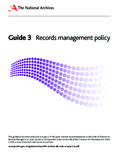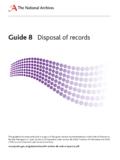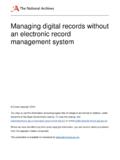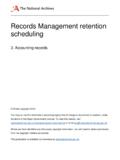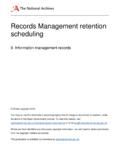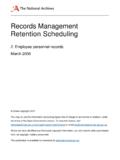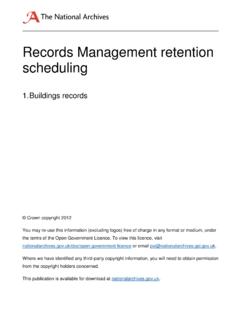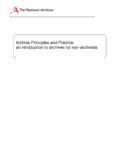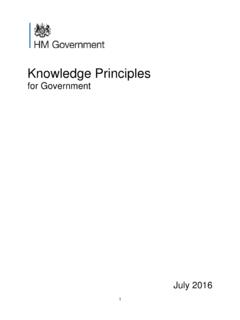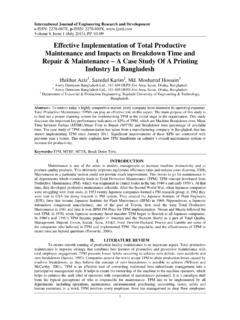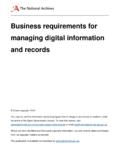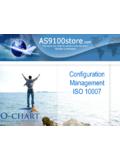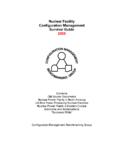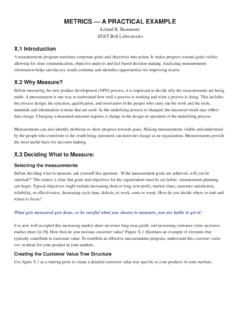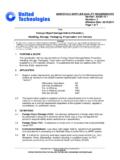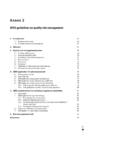Transcription of Guide 4 Keeping records to meet corporate requirements 2010
1 Guide 4 Keeping records to meet corporate requirementsThis guidance has been produced in support of the good practice recommendations in the Code of Practice on records Management issued by the Lord Chancellor under section 46 of the Freedom of Information Act 2000. A PDF version of the full code can be found updated 31 August 2010 Who should read this guideThis Guide is written for people who have no background in records and information management but find themselves responsible for it within their organisation, or have some other reason for acquiring a basic understanding of the subject. What this Guide is aboutThis Guide is one of a series of guides produced to support the good practice recommendations in the Code of Practice on records Management issued by the Lord Chancellor under section 46 of the Freedom of Information Act 2000 (from now on this Code of Practice will be referred to as the Code ).
2 This Guide covers the third good practice recommendation: Authorities should ensure they keep the records they will need for business, regulatory, legal and accountability purposes. An initial and very important step when managing records is to ensure that those records exist in the first place. According to section 8 of the Code organisations need to: decide what records should be kept create business rules or procedures that tell staff what records they should keep of their work and how to do so identify any particular requirements applying to particular records apply the business Guide explains the process in the following sections.
3 1 Why you should go through this process2 Deciding what records should be kept 3 Developing the business rules4 Evidential value and particular controls that might be needed5 Ensuring staff keep records in accordance with the business rules At the end there are references to some further guidance and a list of other guides in this reading this Guide , note that the term Keeping records is used in the same way as in the Code, recording the authority s activities by creating documents and other types of records as well as handling material received . The term keep is used for creating documents as well as, for example, filing incoming emails or also that these guides do not apply to the management of archives, the small proportion of records selected for permanent preservation and transferred to an archives service once they were no longer needed by the authority for current business or legal reasons.
4 Crown copyright 2010 The text in this document (excluding the Royal Arms and departmental or agency logos) may be reproduced free of charge in any format or medium providing that it is reproduced accurately and not used in a misleading context. The material must be acknowledged as Crown copyright and the title of the document about any other use of this material, please write to The National Archives, Information Policy Team, Kew, Richmond, Surrey TW9 4DU or email updated 31 August 20101 Why you should go through this processUnless decisions are made about what records should be kept, organisations are likely either to end up without the information they need or to be overwhelmed by information they do not need.
5 Both carry much information means: systems become clogged up with ephemeral information searching is harder and takes longer, and it can be difficult to identify what is relevant to the business in hand staff and other resources, including storage capacity, are wasted managing information that is not needed identifying the definitive version of a document can be little information means: the organisation has an inadequate corporate memory records required to show accountability or for reference purposes are not there when needed records providing evidence of rights and entitlements are not there when needed there are doubts as to the reliability of what is that the necessary records are kept is a matter of identifying what is significant and what is ephemeral and taking appropriate action.
6 Some organisations leave decisions on what to keep to individuals but this creates risk as two individuals sitting side by side and doing similar work might take a different view of what records they should keep of that work. Individuals need clear guidelines that will ensure that business needs for information about past actions and decisions for records are met. Essentially, an organisation s records will: enable staff to do their work consistently, in full knowledge of the processes, decisions and actions that inform and drive the business ensure the availability of credible and authoritative evidence to protect the rights of the organisation, its staff and anyone else affected by its activities provide corporate memory so that lapse of time does not affect access to and availability of the corporate knowledge resource demonstrate accountability by providing the evidence and information required for any possible internal or external are sometimes kept unnecessarily.
7 This happens when: there is no need for evidence that something has been done a record duplicates evidence or information in one or more other records material reflecting private interests finds its way into the organisation s records that should be kept Minutes of senior management meetings at which key decisions are made. Accountability requires an agreed note of decisions that attributes and dates them. Details of property owned or leased, evidence of occupancy rights and benefits, which will be needed for at least as long as the property is owned and possibly for some time updated 31 August 20102 Deciding what records should be keptEach organisation must decide for itself what records to keep, taking account of the legal and regulatory environment, the nature of its business and its continuing need for evidence and information about how it has carried out that business.
8 The decision requires an understanding of the organisation s purpose and functions, how it carries out those functions, and how it uses the records it holds already. This means investigating and analysing: the functions of the organisation as a whole the functions of the various parts of the organisation the business units1 and the various programmes and projects that complement or sit alongside the business units what information each business unit uses during its work what records result from the work of each business unit how those records are shared with or used by other parts of the is no single right way of tackling this and the approach adopted will depend on the nature, size and complexity of your organisation.
9 What follows is a possible step-by-step approach which you can adopt or adapt as required. The steps are: Step 1: Secure senior management support Step 2: Plan the project Step 3: Preliminary research Step 4: Work with each business unitStep 1: Secure senior management supportSupport from the person with lead responsibility for records management will be essential. (The role of this person is explained in Guide 2.) You will be asking busy colleagues to set aside pressing work to help you in a task that you know will be to their and the organisation s benefit, but which to them is yet another call on their time.
10 You may need sponsorship at a senior level to secure the co-operation of managers of business units but you should also explain what is in it for them. It is important to present the work as something which will bring real benefits and will contribute to management of The term business units is used in the Code, but they could also be known by another name, divisions or sectionsexamples records that do not need to be kept Personal copies of material that is in the organisation s records . Trivial or irrelevant emails and notes, confirming a meeting to be held. Early drafts of documents which are not shared with updated 31 August 2010 Securing support from the person with lead responsibility may require preparation of a business case.
